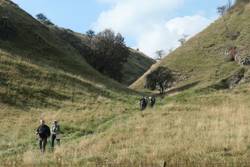Our early October trip was to the magnificent Ravenstor hostel, between Bakewell and Buxton. As usual Friday night saw us all homing in on the hostel, some via pubs, some to eat at the hostel, George via a traffic jam on the A14.
For our Saturday walk, we decided to head out from the hostel to enjoy the delights of Tideswell Dale, Cressbrook Dale and Millers Dale. These dales are all steep-sided limestone valleys with Tideswell now being dry, the river having been swallowed into the porous rock. The valley led us along to Tideswell village itself and its church “The Cathedral of the Peaks”. We had been hoping to have a look inside, but the church was locked – both to our surprise and the surprise of the volunteers who were supposed to be minding the interior. We will never know the magnificent splendours that led it to be called “The Cathedral of the Peaks”. After a pleasant break gracing the commemorative benches in the churchyard we decided to press on to the next lovely village, Litton.
Now there was a pub in Litton but we arrived far too early to partake. However we were delighted to see a sign for coffee and cake at the Post Office, and very good it was too. After happily boosting the local economy we sat around the village green enjoying our purchases and the jokes in the phone box. Why don’t insects get covid – because they have lots of anty-bodies. There were more...
From Litton we headed into Cressbrook Dale and had our lunch high up on the side of the valley. Unlike Tideswell, Cressbrook Dale has a river in it, and at the far end was the mill – now high-end apartments. We continued into Millers Dale for a view of the Monsal Head viaduct, before heading down the closed path by the Cressbrook Tunnel. The path had been closed the last time we came here and in the intervening years it hadn’t improved. We managed to shimmy through and continue along Millers Dale back towards Ravenstor, pausing for a drink or two at the Anglers Rest to steady our nerves.
Meanwhile George had been working his fingers to the bone to prepare a fabulous feast for us to celebrate his 75th birthday. It seems a bit unfair that the birthday boy was doing all the work, but rather nice for the rest of us. There were cameo appearances from Helen and Colin to help celebrate and we wound up the evening with a presentation of a wee dram to George.
Sunday came and Helen joined us for breakfast, revealing that her campsite was next door to a pagan festival where they were drumming all night. Suddenly the snoring in the men’s dormitory doesn’t seem so bad. As the forecast wasn’t so nice we decided to head for the bright lights of Buxton, but in the end, we went for a walk anyway. We’re tough enough to stand a bit of drizzle! There were reasonable views from Solomon’s Temple with a nice man shouting "keep at it" and "well done!", only for us to realise he was motivating the cross country runners and not us.
From the temple we headed across Axe Edge Moor, returning to Buxton via the mysterious HSE test site at Harper’s Hill. Amidst the warnings about CCTV and no loitering, there were burnt-out cars and an enormous rusty tube (apparently representing a tube tunnel in the tests). All this led us back to Poole’s Cavern where we enjoyed the café rather than the cave before going our separate ways. Another corker of a weekend.
Ali
Tufa Terraces
Below the HSE testing site on Harper Hill, there was a valley filled with terraces of white and blue pools. It looked both stunning and strange. A quick Google revealed that this was the legacy of the Victorian lime works on the hill above. Locally mined limestone was fired in kilns to produce a mixture of calcium oxide and hydroxide, known as lime. It was a pretty inefficient process, so there was still quite a lot of lime in the tons of waste they dumped from the kilns onto the hillside. Over time rainwater has dissolved the lime to produce a caustic alkaline which eventually makes its way out of the hill at the bottom. On contact with air, the solution absorbs carbon dioxide and this reacts with the calcium hydroxide to form insoluble calcium carbonate. It’s this carbonate which precipitates out to form the white terraces. There are places where this happens quite naturally, but here it is old industrial waste.
Ali
